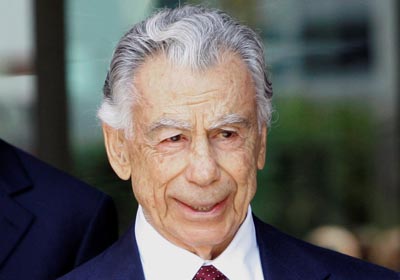Chairman, Tracinda Corporation; built the MGM Grand in Las Vegas and owned MGM studios
Kirk Kerkorian, the media-shy investor who became one of the richest Americans by betting his money on ventures like casinos and film studios, died in June 15 2015 at his home in Beverly Hills, Calif. He was 98. Richard E. Sobelle, general counsel of Mr. Kerkorian’s company, the Tracinda Corporation, confirmed the death. Born poor, Mr. Kerkorian was a brawling amateur boxer, a daredevil pilot and a high-stakes poker player before figuring out safer ways to amass a multibillion-dollar fortune. He pursued strategies that baffled business rivals and Wall Street analysts and that left him sometimes on the verge of bankruptcy. Other times, his moves brought him windfalls. He bought and sold MGM three times. He created a commercial airline, sold it and then purchased it again before reselling it for good. And in his 80s he made an unsolicited and successful bid for Mirage Resorts, the giant casino company controlled by Stephen A. Wynn, the uncrowned king of Las Vegas. Kerkor Kerkorian — he Americanized his name to Kirk as a boy — was born in Fresno, Calif., on June 6, 1917, one of four children of Armenian immigrants. His mother, Lily, was a homemaker; his father, Ahron, was a fruit merchant whose get-rich-quick schemes often left his family struggling to stay afloat. In World War II, Mr. Kerkorian ferried bomber planes across the Atlantic and as far as India for the British Royal Air Force. After the war he bought surplus military transport planes, refurbished them and sold them around the world, using the profits to buy a small air charter operation, based in Los Angeles, in 1947. Kerkorian often flew Hollywood entertainers to Las Vegas, which was becoming a gambling capital, and joined them at the blackjack and dice tables, where he became renowned as a high roller. It was in Las Vegas where he met Jean Maree Hardy, a dancer and choreographer. They married in 1954 and had two daughters. That marriage ended in divorce after almost 30 years. (His first marriage, to Hilda Schmidt, had also ended in divorce, in 1951.) Kerkorian bought property in Las Vegas, just off the Strip, in 1962. That year he merged his charter company, Trans International Airlines, with the Studebaker Corporation, retaining operating control. Using Studebaker revenue, he expanded the airline’s fleet and destinations. He then repurchased the airline in 1964 and left Studebaker. Over the next three years he sold the airline in two separate transactions, making more than $100 million in overall profits and funneling the proceeds into the three business arenas — airlines, gambling resorts and film studios — that would sustain him as an investor for the rest of his life. The original MGM Grand opened in 1973 with more than 2,000 rooms. A year later, Mr. Kerkorian increased his holdings in MGM to just over 50 percent. With a strong flow of revenue from his Las Vegas operations, Mr. Kerkorian sought to expand his Hollywood investments. In 1978 he bought 25.5 percent of Columbia Pictures, which he later sold. In 1981, he lost a bid to buy 20th Century Fox but succeeded in acquiring United Artists. He then split MGM into two publicly owned entities: MGM/UA Entertainment, which included film and television production and a large library of films, and MGM Grand Hotels, which owned and managed hotels, casinos and luxury cruise ships. By 1986, Mr. Kerkorian had agreed to sell MGM/UA, which was struggling, to Ted Turner, the cable television magnate, for $1.5 billion. Hollywood rivals and Wall Street analysts considered it a good deal for Mr. Kerkorian. It became a terrific one a year later, when Mr. Turner, crushed by debt, sold all but MGM’s film library back to Mr. Kerkorian for only $300 million. In effect, Mr. Kerkorian had sold the MGM library for $1.2 billion. Mr. Kerkorian did not hold on to MGM/UA for long. In 1990 he sold it to the Italian financier Giancarlo Parretti and his holding company, Pathe Communications, for $1.3 billion. In 1995, with the support of its former chairman, Lee A. Iacocca, he proposed to buy Chrysler for $22.8 billion and take it private. Chrysler’s board rejected the offer. In 1998, Daimler-Benz, the maker of Mercedes-Benz automobiles, acquired Chrysler in a $36 billion merger. The deal was a windfall for Mr. Kerkorian, raising the value of his Chrysler holdings to nearly $5 billion, more than triple the original investment he made in 1990. As he neared 88 in 2005, Mr. Kerkorian made yet another splash on Wall Street by buying a 9.9 percent stake in General Motors. He sold his G.M. investment in 2006. In 2008 he acquired a 6.5 percent stake in the Ford Motor Company, only to sell it within a few months after Ford’s stock plummeted In 1999, Mr. Kerkorian married Lisa Bonder, a former tennis pro. The marriage lasted only one month, and in 2002 she asked a Los Angeles Superior Court for the largest child-support award in California history, $320,000 a month. A court later awarded her a much smaller amount after it emerged that the child was not Mr. Kerkorian’s. His daughters, Tracy Kerkorian and Linda Kemper, as well as three grandchildren survive him.
